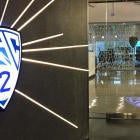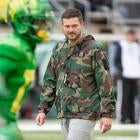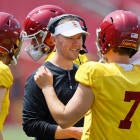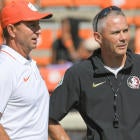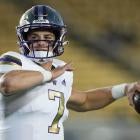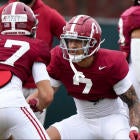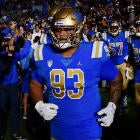J.D. Wicker's phone blew up Tuesday afternoon. What the California State Universities Board of Trustees had just announced floored him.
The chancellor of the CSU System announced that its 23 universities would go almost exclusively online for the fall. Almost no students in classrooms. Among those 23 schools is San Diego State where Wicker has been athletic director for the last three-plus years.
"It caught me a little out of left field," he told CBS Sports. "I'm not going to lie. We had to scramble a little bit. It wasn't exactly what we had been talking about."
Not in terms of playing football anytime soon. That decision -- whether a school should play football without students being allowed on campus -- has turned out to be one of the most significant in the return-to-play discussion. Depending who you ask, it may be the deciding factor.
Those 23 universities include not only San Diego State but Fresno State and San Jose State, one-fourth of the Mountain West. The announcement pushed closer to reality thoughts shared last month by MWC commissioner Craig Thompson. His league might have to move forward on the field without those schools if they can't play this fall.
That brings up a looming question that grows bigger by the day: Knowing all schools want to play football in the fall, which will actually be allowed to play if the coronavirus remains so stubborn?
In that discussion, the West Coast has never looked more left out.
"We're in never never land," said Stanford coach David Shaw. "We don't know what's going to happen. My hope is the majority of universities can participate so we can have a real season."
College football's stakeholders have already indicated they're ready to move forward in 2020 without all 10 FBS conferences and perhaps even without all the schools within those conferences.
"The best thing would be to be united," Colorado AD Rick George said of the 10 conferences. "But at the end of the day, that may be difficult to do."
The Pac-12 alone is on alert. The immediate prospects for major-college football in the state of California do not look good. Gov. Gavin Newsom has already said large gatherings are doubtful for the rest of the calendar year. The Los Angeles County stay-at-home order "with all certainty" will be extended for three months, according to L.A.'s public health director.
What that means for USC and UCLA football isn't clear.
Oregon Gov. Kate Brown recommended last week any large gatherings would have to be canceled or significantly modified through at least September. What that means for Oregon and Oregon State isn't clear.
"Until there is a vaccine, unfortunately, we will not be going back to life as we knew it," Brown said.
The Pac-12 released this statement after the Cal State system announcement: "The Pac-12 and our member universities will make our own determinations on when our student-athletes can return to play and when and how campuses will reopen to students."
It's the canceling of March conference basketball tournaments in reverse. On March 12, major conferences eventually came together to reach the right decision -- cancel league tournaments as the pandemic spread throughout the country.
As football nears, the return-to-play philosophy is clear: every conference for itself.
Anything, it would seem, to grab at least a portion of the TV rights revenue that is the financial underpinning of most athletic departments.
The Pac-12 isn't the only conference contemplating a schedule made up of league-only games. That would eliminate one hurdle -- concern over playing other conferences that may or may not be cleared to participate.
The Pac-12 has discussed "building some play into our schedule" to take a week or two off if a team has to shut down because of the virus, Shaw told CBS Sports. Those postposed games then could be played at the end of the season.
The uncertainty deepened on Tuesday. Alabama AD Greg Byrne and USC AD Mike Bohn shot down a report that the Crimson Tide were already speaking with TCU about replacing the Trojans in the season opener on Sept. 5. That switch would ostensibly eliminate any worry about USC being able to travel out of its California hot spot.
It would also douse another concern. Texas Gov. Greg Abbott has mandated that travelers from California enter a 14-day quarantine after entering the state.
With the fifth-most COVID-19 cases in the U.S., California could have its own issues with teams traveling within its borders to play. TCU AD Jeremiah Donati has reportedly reached out to his Cal counterpart talk about contingency plans for their Sept. 5 opener in Berkeley, California. That's the same day as the scheduled Alabama-USC showdown.
The games are on, for now.
"We are planning to play Cal [in] Week 1," Donati told CBS Sports. "If for some reason we cannot do so, we'll look at other options."
An interruption in any conference's schedule would impact leagues throughout the country. Pac-12 and MWC teams play 11 games against one another in 2020. Only three of those games are set to be held in California or Oregon.
Two games involve the three California-based MWC schools: UCLA at San Diego State and Fresno State at Colorado, both on Sept. 12.
"Let's go right to the Pac-12 with the states of Washington, Oregon and California supposedly [together in reopening]," Thompson told CBS Sports. "What if the two Arizona [teams], Utah and Colorado are good to go and those are other eight are not?"
Arizona Gov. Doug Ducey is opening his state for professional teams to begin activities on Friday. One issue: Those teams -- the MLB's Diamondbacks, NFL's Cardinals, NBA's Suns and NHL's Coyotes -- probably won't resume activities until cleared by their leagues.
Arizona State AD Ray Anderson told CBS Sports that he is in "full alignment" with school president Michael Crow and coach Herm Edwards on the issue of students being on campus in order for the team to play. He did not elaborate.
The CEOs at the three California MWC schools have yet to commit to students having to be on campus as a condition of playing football. The league released a statement Tuesday saying, "No decisions on athletics have been made."
"I don't really react to it," Wicker said of the Cal State system's decision. "There is way too much water that has to go under the bridge. It's May 13. There's so much that have to play out."
Whatever the future holds, it is not clear and definitely not unified.
That was made apparent in the last month. During an April 15 call, Vice President Mike Pence was told by some conference commissioners that college football would not be played without students on campus. Commissioners, ADs and administrators nationally have since waffled on that stance.
On April 21, Thompson said there will be no college athletics in the MWC until campus dorms and housing were operating at "full mode."
On April 24, South Carolina AD Ray Tanner said there was a good chance the conferences would not be "aligned."
On May 5, Notre Dame AD Jack Swarbrick made news when he said there was a "significant chance" the conferences will not begin play together.
This week NCAA president Mark Emmert said the association would not mandate conditions for a return to play. Good decision. For an organization that continually preaches it represents the membership, it will be the school presidents, conferences and medical professionals who make that call.
"To me, there are a lot of people making a lot of declarative statements that seem to be more rigid than I think is prudent," Shaw said.
SEC commissioner Greg Sankey may have caused the biggest stir late last month during a radio interview. He first said the 10 conferences are "interconnected." However, Sankey also said, "I'm not sure it does" mean the conferences all have start the season together.
"He did say that. That's for sure," George said.
You can understand Wicker's desire to get going. He graduated from Mississippi State and spent much of his career in the South where football is king (Georgia, Southern Miss, Georgia Tech).
His SDSU athletic department is rolling. He is overseeing the construction of a new football stadium. He has a new coach (Brady Hoke) taking over one of the country's best Group of Five programs. In basketball, the Aztecs were considered a No. 1 seed and Final Four favorite before the NCAA Tournament was canceled. Since 2010, only Ohio State, Michigan State and Oregon have better combined winning percentages in basketball and football.
Now?
"We decided we didn't have enough chaos in our lives," he said, sarcastically.
Wicker is planning for a "worst-case scenario because it's the easiest one to plan for." Within that plan is hope. SDSU has a hybrid plan that would allow some students to be on campus.
In a recent call with NCAA chief medical officer Brian Hainline and MWC ADs, there were encouraging signs in terms of testing. It's becoming increasingly clear that little progress will be made in this discussion without reliable testing.
Wicker continues to aim for July 7 as a date athletes can return to campus.
Whether they can snap a football this season, however, remains a mystery.












